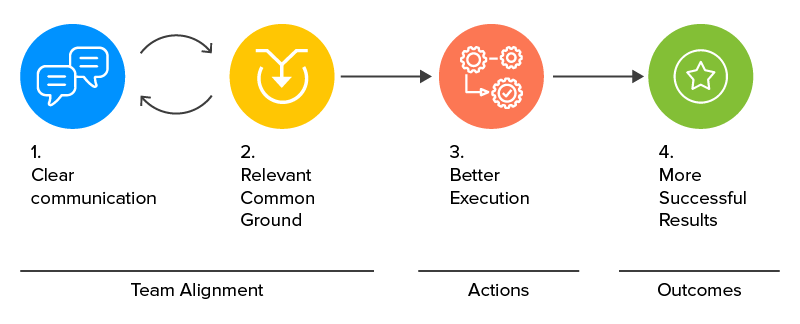How Cross-functional Teams Help In Building Better Digital Products?
Did you ever feel like your organisation is working in silos? Designers want to deliver meaningful experiences, Marketing team is keen on entering a new vertical while sales is focussed on bringing in more and more leads, but all of this happens in isolation.
Even though the roles of each of these departments are varying in nature, their priorities and end goals must be clear and consistent. Otherwise it’s a sheer wastage of the businesses resources spent across different directions.
Cross-functional teams foster cohesion within the company, reduce wastage of valuable resources and enable you to maximise your efforts in order to accomplish goals faster.
More often than not, the underlying reason why companies struggle with building better digital products is how they prioritize milestones and the linear approach, where work is passed from one team to another without fully channeling the skill and expertise of each discipline.
Building a digital product requires team effort. Each discipline has a role to play and sometimes, these roles are overlapping. A great idea can come from any person and any team. Organisations looking to grow with agility and speed need to build cross-functional teams and bring them to the center stage. When the skill of each discipline is valued, their perspective is heard and every discipline is represented at the table, it results in quality solutions.
So, What is a Cross-functional Team, anyway?
A Cross-functional team brings people together from different functional expertise. By mutually exploring the prospects of a project and through shared expertise the team accomplishes a common goal.
There are so many crucial roles in digital product design and development– Designers, Product Managers, Business Analysts, Engineers, Quality Analysts, Marketing Specialist, and the list goes on.
The approach behind a cross-functional team is to gather a good mix of people from various disciplines to work on a project together. It is about brainstorming ideas, uncovering different and unique perspectives, and channeling an umbrella of expertise towards achieving one common goal – how to build a unique digital solution.

The idea behind cross-functional teams stems from agile methodology. Every discipline deserves a seat at the table regardless that their department’s primary phase is underway.
What’s the need for a Cross-functional Team?
When teams collaborate together in every phase and stage of creating a digital product, the result is impactful. In a cross-functional team, each person understands the role of other team members and views the product not only from the perspective of his/ her field but as an entire product and as a team effort.
Having a Cross-functional team is extremely crucial because every person brings so much value to the table. When a diverse set of people come together, a problem is approached in all possible ways and we are able to uncover unique perspectives.
For instance, when an Engineer has a seat at the table right when the project kicks off, identifying the best technology to build a product becomes easy. While others in the team may not be technically adept, an Engineer brings a different level of technical understanding to the front, especially when they have worked with cutting-edge technologies in the past.
As a full-cycle app development company, we believe in agile development with cross-functional teams. By building cross-functional teams, we were not only able to reduce the cycle time in new product development, but our teams also demonstrated flexibility in adapting to changing market needs and were able to develop innovative solutions at a faster pace.
While the number of Designers involved in a project will be more in the Design phase and the number of Engineers will rapidly increase in the Development phase, having representatives from each discipline throughout the app development process regardless of the phase adds a lot of value to the product.
The approach behind a cross-functional team resonates quite well with the practices of DevOps.
DevOps can be seen as a cultural perspective on how teams should be engaged in working the right way.
In today’s fast-paced world, with more advanced projects coming up, the need to move faster and be agile is ever-growing. DevOps addresses this concern – it makes development, operations, and other groups within an organization to come together, collaborate closely on shared goals and deliver software faster and more reliably.
Just like DevOps emphasizes close collaboration between software development and operations, having a cross-functional team for the entire product-development process improves collaboration across disciplines like Strategy, Design, Development, Testing and results in quality outcomes.
Benefits of Cross-functional Teams in Digital Product Development
The advantages of cross-functional team in digital product development are manifold.
When all disciplines collaborate closely and everyone is invested in maximizing their contributions towards the project, it results in the best product possible.

1. Knowledge Sharing
The key idea behind accomplishing goals through interdisciplinary work is the exceptional variety of talent figuring out how to create something that is meaningful and brings value to end-users.
Confronting new perspectives, learning from others and looking at things holistically impacts the quality of solution and results in a robust product.
2. Alignment on Goals
In a cross-functional team, people look beyond their roles and responsibilities and are focused on accomplishing the common goal. There is total alignment on set milestones and people collaborate together to achieve it in the best way possible.
3. Less Handovers
When you collaborate across disciplines and everyone is present throughout the product development lifecycle, it minimizes handovers and speeds up the processes.
4. Teamwork
Working together facilitates teamwork. It brings people closer and improves communication. It is easy to talk through the issues and brainstorm on great ideas. Collaborating closely builds respect and trust in teammates.
5. Identifying issues
When a project is handled by a cross-functional team, everyone is up to date with the project’s progress. When people work simultaneously and don’t focus solely on their disciplines, it is easy to identify bugs and flag issues that may trouble the user.
6. Iteration
As mentioned above, cross-functional teams are up to date with all the issues within a project, which implies, making changes to the design or the code becomes easy. Testing and iteration can be done simultaneously and it saves a lot of time, effort and money.
7. Positive customer experience
While there are many different roles in an organisation, each of these functions exist to serve the customer. By encouraging effective communication across teams,it becomes easy to provide a meaningful tailored customer experience.
8. Increased Innovation
When a group of people from different functional expertise come together to solve a common problem, it is relatively easy to generate innovative and comprehensive solutions.
Companies that use cross-functional teams include marketing insights, sales conversations, product usage data and other relevant sources of information into keen consideration when making product decisions which results in smarter decision making. The power of cross-functional teams is to drive better decision making through business-wide learning.
Challenges faced by Cross-functional Teams
Effective cross-functional team collaboration is the key to tackle an organisation’s biggest problems. However, there are certain problems with cross-functional teams and sometimes they can be difficult to manage.
- Conflicting Goals
Each discipline comes with a set of roles and responsibilities. Often times, when functional experts from different teams come together, they tend to give less priority to the project and are more focussed on their own goals.
In such scenarios, it is essential for leaders to identify strategic goals to make sure there is clarity of purpose and the whole team is aligned on the goals of the team or the company.
- Too much or too little Communication
With a cross-functional team, it is crucial to decide the right measure of communication. Too many unnecessary meetings lead to loss of time and can hamper productivity while little communication regarding the project status and iterations can negatively impact a project.
- Choosing Ideas
In a cross-functional team, you may give up on good ideas when others don’t like it.
While sometimes, it becomes easy to let go off complicated ideas and work more efficiently. This is where Discovery Workshop and operating in an agile manner comes into the picture. Scrum Methodology helps cross-functional teams encounter the biggest challenges and achieve great outcomes.
- Leadership
In a self-organising team with no clear leader, there is a possibility that the team may get lost and feel there is no clarity of purpose. It is essential to have a leader that can provide sufficient oversight so that small problems do not snowball into a bigger crisis and the team is able to collaborate efficiently.

Conclusion
Cross- functional teams often struggle because the organisation lacks a structured approach. Teams are affected by insufficient oversight, conflicting goals, lack of accountability and organisation’s failure to measure the impact of cross-functional collaboration.
Corporate structures are reorganizing themselves into cross-functional teams since the advantages are manifold. It may take time to adopt the cross-functional team approach to building products but it has nearly three times the success rates and is worth the rewards.

strategies your digital product..



